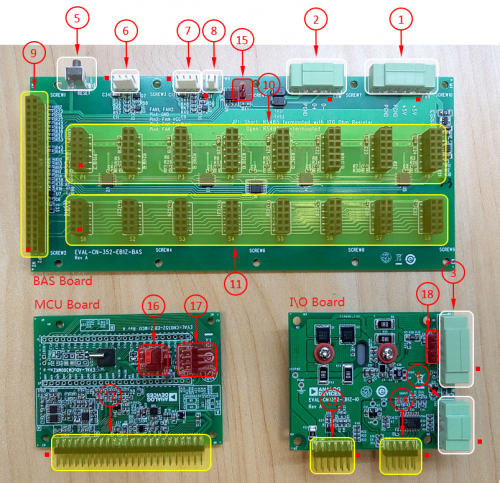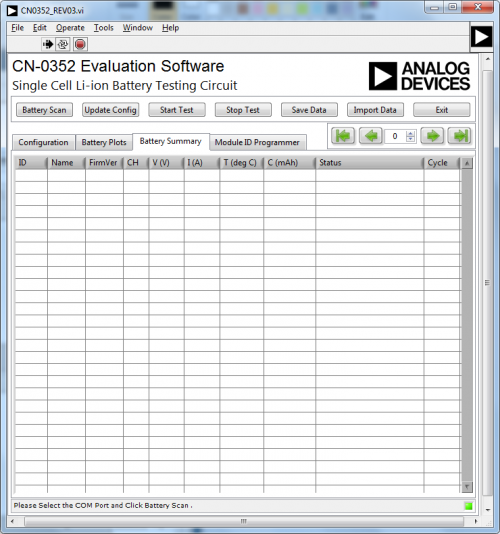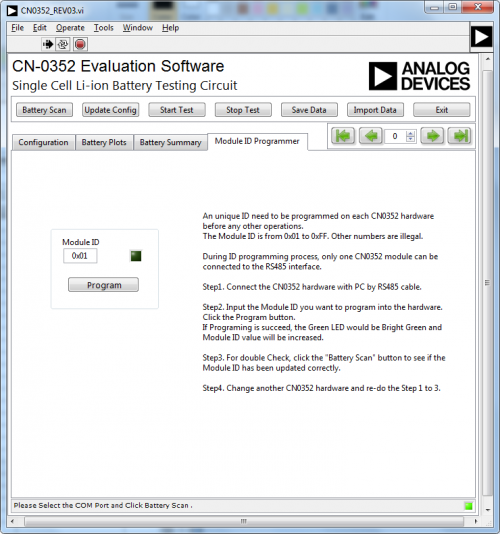 This version (01 Apr 2016 11:30) is a draft.
This version (01 Apr 2016 11:30) is a draft.
This is an old revision of the document!
CN-0352 is a cost effective, multi-channel battery testing reference system designed for signle-cell Li-ion battery with open circuit voltage(OCV) between 3.5V to 4.4V.
It can handle charging-discharging cycle with CC(Constant Current), CV(Constant Voltage) charging mode with configurable termination control. During testing, the battery information including voltage, current and temperature are gathered, then sent and storted on PC through RS485 communication bus.
Each CN-0352 battery testing module could handle 8-channel Li-ion battery cell. With RS485 commumication bus, the testing channels could be extended upto more than hundred channels. The limitation is the communication bandwidth of RS485.
THIS EVALUATION SYSTEM INTERFACES TO LITHIUM ION BATTERIES WHICH CAN BE DAMAGED, CATCH ON FIRE, OR EXPLODE IF OVERCHARGED, OVER-DISCHARGED, OR SUBJECTED TO SOURCE OR SINK CURRENTS THAT EXCEED THE BATTERY MANUFACTURER’S SPECIFICATIONS. TAKE ALL NECESSARY STEPS TO PROTECT USERS DURING OPERATION.
The EVAl-CN0352-EB1Z, battery test system in Figure below is composed of multiple I/O boards (EVAL-CN0352-EB1Z_IO) for handling the charging and discharging process, an MCU board (EVAL-CN0352-EB1Z_MCU) for battery data acquisition, testing, monitoring,and temperature management, and a backplane base board (EVAL-CN0352-EB1Z_BAS) that provides the signal interconnections between the MCU board and the multiple I/O boards.
The picture below shows all 3 type of boards and give each connector a serial number for better understanding.
See the tables below with detais of the connectors and jumpers on each board.

External Connectors are used to connect with external power supply, FAN, batterys and temperature sensors. It is important to connect them correctly by know the pin definition on each of them. See the table below for this information.
| Connector NO. | Pin No. | Pin Name | Function | Note |
|---|---|---|---|---|
| 1. Power Input Connector | 1 | +5V | 5V DC Power Input | Two Pins for High Current |
| 2 | +5V | 5V DC Power Input | ||
| 3 | GND | Ground | Two Pins for High Current | |
| 4 | GND | Ground | ||
| 2. RS485 Interface Connector | 1 | D- | Data + | |
| 2 | D+ | Data - | ||
| 3 | GND | Ground | ||
| 3. Battery Connector | 1 | B- | Power Path to Battery Cathode | 4 wire Kelvin Connection |
| 2 | S- | Sensing path to Battery Cathode | ||
| 3 | S+ | Sensing path to Battery Anode | ||
| 4 | B+ | Power Path to Battery Anode | ||
| 4. Temperature Sensor Connector | 1 | T1 | Temperature Sensor Pin1 | Thermisor10k by 2 wire Connection |
| 2 | T2 | Temperature Sensor Pin2 | ||
| 5. Reset Push Button | x | x | x | Push to reset whole system |
| 6. PWM FAN Connector 1 | 1 | FAN GND | FAN GND | |
| 2 | FAN Power | FAN Power,Connect to FAN | ||
| 3 | Speed FB | FAN Speed feedback input | ||
| 4 | PWM Control | FAN Speed PWM Control Output | ||
| 7. PWM FAN Connector 2 | 1 | FAN GND | FAN GND | |
| 2 | FAN Power | FAN Power,Connect to FAN | ||
| 3 | Speed FB | FAN Speed feedback input | ||
| 4 | PWM Control | FAN Speed PWM Control Output | ||
| 8. FAN Power Connector | 1 | FAN Power | FAN Power,Connect to 12V DC Supply | |
| 2 | FAN GND | FAN Power,Connect to GND of 12V Supply |
It is necessary to have one BAS board, one MCU board and at least one I/O Board to setup the demo system. The Internal Connectors are used for EVAL-CN0352-EB1Z module setup. MCU and I/O board need to be plugged into the connectors on BAS board correctly.
| Connector NO. | Function | Note |
|---|---|---|
| 9. | Hookup with MCU Board | Marked with JP2 on BAS board. See schematics for pin definition. |
| 10. | Hookup with I\O Board | Marked with P1~P8. See schematics for pin definition. |
| 11. | Hookup with I\O Board | Marked with S1~S8. See schematics for pin definition. |
| 12. | Hookup with BAS Board | Marked with J4 on MCU board. See schematics for pin definition. |
| 13. | Hookup with BAS Board | Marked with CNP. See schematics for pin definition. |
| 14. | Hookup with BAS Board | Marked with CNS. See schematics for pin definition. |
There are some jumpers on each board with different function listed below. See the table as a summary for the function and suggested configurations.
| Jumper NO. | Configuration | Function | Note | |
|---|---|---|---|---|
| 15. RS485 Termination Jumper | On | 120 Ω Termination Turned on. | ||
| Off | 120 Ω Termination Turned off. | Default Configuration | ||
| 16. LK1 to LK3 on MCU Board | On | Provide Power for MCU | Always put on for correct operation | |
| 17. J3 on MCU Board | x | JTAG interface for MCU Debug | ||
| 18. JP2,JP3 on I\O Board | Both On | Connect to Battery by 4 wire Kelvin Connection | Recommended | |
| Both Off | Connect to Battery by 2 wire Connection | Have lead error |
The picture below shows the way to hook up the BAS, I\Os and MCU boards together. It is necessary to have at least one I/O board to make system working correctly.
See the picture below showing the whole CN0352 demo system.
There is a CN0352 Design Support CD in the CN0352 CftL package. Insert the CD in to your CD ROM driver and located the installation file under the location CD ROM..\CN0352 Installer\setup.exe. Double Click the setup.exe and follow the installation wizard to install the evaluation software and drivers on your PC.
If you see the picture below, then click finish to complete the software installation.
Italic Text
Double click the CN0352.exe, then the interface of CN0352 evaluation software shows up.

The evaluation board would send related command frame down to one or more EVAL-CN0352-EB1Z demos one the same RS485 bus regards to the button been clicked by customer. Then the EVAL-CN0352-EB1Z addressed will do related operations and may or may not send back feedback data.
There are Battery Status and Test Procedure blocks are both refreshing to show the latest battery status that the software just received from EVAL-CN0352-EB1Z. The switching Channel Switching tab is used to switch to any of the available battery channel that customer want to look at.
 : Click to switch to the 1st Battery available.
: Click to switch to the 1st Battery available. : Click to switch to the previous Battery available.
: Click to switch to the previous Battery available. : Switch to the expected battery channel by input the battery index.
: Switch to the expected battery channel by input the battery index. : Click to switch to the next Battery available.
: Click to switch to the next Battery available. : Click to switch to the last Battery available.
: Click to switch to the last Battery available.For easy to do the operation and see the result, the Configuration block and Battery Status,Test Procedule on the same tab.
Battery Plots showns all the battery information since the testing started. All the information are shown on the plot.

 The Battery Summary tab listed all latest informations of each battery on one row. It is very convenient to see the any battery interested without switching the channel.
The Battery Summary tab listed all latest informations of each battery on one row. It is very convenient to see the any battery interested without switching the channel.
 Before doing the test, each EVAL-CN0352-EB1Z sharing the same RS485 bus need to have a unique ID. This ID is a 8-bit ID. The Default ID for the EVAL-CN0352-EB1Z is 0xFF. If there are multiple modules sharing the same RS485, than each Module need to have a different ID. This Module ID Programmer is the tools for assigning the ID.
Before doing the test, each EVAL-CN0352-EB1Z sharing the same RS485 bus need to have a unique ID. This ID is a 8-bit ID. The Default ID for the EVAL-CN0352-EB1Z is 0xFF. If there are multiple modules sharing the same RS485, than each Module need to have a different ID. This Module ID Programmer is the tools for assigning the ID.